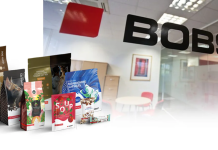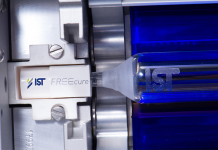Marketing manager Industrial Inks at Agfa Graphics, Marc Graindourze will speak about Agfa Graphics’ industrial inkjet inks for industrial applications, in particular concerning direct printing on objects and packaging using low-migration inkjet inks, at the Industrial Print Show in Hannover, Germany, taking place from 8-10 April 2014.
Agfa Graphics has become the leading supplier of Low Migration inks (LM) UV-curable inkjet inks to system integrators and OEM’s that are building printing solutions. These printing systems are often integrated in a complete production line for printing on foils or labels (sheet-to-sheet, roll-to-roll or roll-to-sheet) or direct onto the package container, thereby also saving the cost of the label material.
The food packaging industry is the primary driver for LM inks and other applications, in particular pharmaceutical packaging, require the use of LM inks. Where industrial UV inkjet inks in general cannot be considered commodity products but always designated formulations tuned to a specific application, this certainly holds for Low Migration inks. And even in a generic sense, Low Migration (LM) inks as such do not exist.
One specific ink formulation can be developed that is safe for food packaging in combination with certain other variables, such as a given substrate, a specific type of foodstuff under certain storage conditions, to be handled or processed in a given temperature range and over a defined amount of time, etc. But it is not guaranteed that this same ink formulation will be food-safe for all other combinations of substrate, food type, and storage or processing conditions.
There are also several ways ink components can contaminate the contents of the product container on which print is being applied. The two most important ones, migration and set-off, are briefly explained: Ink migration means that ink compounds reach the food product by diffusion through the packaging substrate. Set-off means that ink compounds from the printed layer are transferred to the food-product facing side of the substrate. This occurs for instance when printed products are stacked or rolled up.
Other than physical barriers, obvious measures for keeping migration or set-off at bay are high viscosity formulations and rapid through curing. The curing degree of standard UV inkjet inks is typically between 85 and 95% and sufficient for the required specifications in non-food applications. However, the use of inks with low-molecular weight compounds and other substances or byproducts – all prone to leaching out of the ink layer – may involve risks in applications where food safety is concerned, especially if the degree of ink curing is far from complete.
For UV inkjet the demand for high ink jet throughput speeds at the highest possible resolution has led to the design of sophisticated print nozzles that require low viscosities in the range of 10 – 30 cps. This requirement is a limiting factor in the selection of viscosity-related ink components and a particular constraint to the choice of polymerisable compounds. In consequence, only a very limited amount of oligomer substance is possible in UV-inkjet inks, the bulk of which will be constituted as a mix of low-molecular weight, hence low-viscosity monomers. In primary food package printing the use of low-molecular weight monomers increases the risk of migration to the food.
Migration, however, is not restricted to unreacted monomers but may also involve photo initiators and some additives in the UV-inkjet ink. Using high-purity ink compounds that do not contain by-products – which are typically low in molecular weight and thus prone to migration – is one first step towards LM inkjet inks, but this is not enough. Agfa Graphics has developed and patented a specific ink technology, denoted as the Complete Cross-linking technology (CCT).
By controlling the reactivity of polymerisable compounds, combined with photo-initiators suited for low migration, the polymerisation kinetics can be monitored to obtain a degree of cross-linking that is nearly 100 per cent complete. ??Use of the CCT technology in the LM ink, not only keeps the migration of monomers at bay but also prevents the migration of photo-initiators and their break-down products. To do so the Agfa LM inks comprise one or more so called diffusion hindered photo-initiators.
These are photo-initiators that exhibit a much lower mobility in a cured ink layer than mono-functional photo-initiators, such as benzophenone. ??With the increasing demand for low-viscosity UV inkjet inks that can be used successfully and with good jetting properties in the newest generation of high-speed and high-resolution print heads, the CCT technology is an elegant solution for low migration UV ink formulations that can be safely applied in the most demanding segment of food packaging.
Agfa Graphics Low Migration UV inkjet inks have proven to deliver food safe digital print solutions in demanding applications of direct printing on primary food packaging (especially containers), including fulfilling the other functional needs of these applications. Agfa Graphics is therefore targeting a broad range of applications wherefore Low Migration inks are recommended, including aluminium blister foils, labels, foils and more.





















